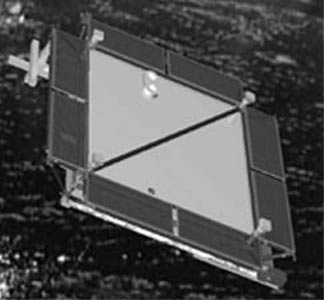Thank you very much for visiting Gunter's Space Page. I hope that this site is useful and informative for you.
If you appreciate the information provided on this site, please consider supporting my work by making a simple and secure donation via PayPal. Please help to run the website and keep everything free of charge. Thank you very much.
IMEX (UNEX 2)

IMEX (UNEX 2) [CU/LASP]
The IMEX (Inner Magnetosphere Explorer), was to study the response of Earth's Van Allen radiation belts to variations in the solar wind. The energetic charged particles (mainly protons and electrons) that comprise Earth's trapped radiation zones are potentially hazardous to both astronauts and satellite systems. IMEX was to be launched into a 350 kilometer by 35,000 kilometer elliptical orbit around Earth with instruments to measure on a regular basis the populations of energetic particles and related magnetic and electric fields throughout the radiation belts.
Data obtained with IMEX during its 10-hour orbital sweeps through the Van Allen belts should lead to significant improvements in our ability to predict hazardous conditions in Earth's radiation environment and our understanding of the underlying physical processes that connect the solar wind with the state of the Van Allen belts. This would be especially important during the upcoming maximum in the solar cycle expected in 2001. The Principal Investigator for IMEX was Dr. John Wygant of the University of Minnesota in Minneapolis. Drs. Daniel N. Baker and Xinlin Li of the University of Colorado's Laboratory for Atmospheric and Space Physics (LASP) had major Co-Investigator roles in IMEX. LASP was to have the responsibility to design, fabricate, test, and operate the IMEX spacecraft.
The IMEX experiment, including launch as a secondary payload aboard an Air Force Titan-4(02)B IUS rocket in 2003, was to cost $12.8 million. About half of that funding was to come to CU/LASP to support the spacecraft, science, and operations roles.
Originally planned to be built on a hexagonal prism shaped bus similar to SNOE, the design was later changed into a flat rectangular structure. It was to be spin stabilized.
IMEX would have featured following instruments:
- FIELDS: a double probe instrument measures DC to 20 Hz electric fields between .05-500 mV/m samples up to 40 kHz electric fields in burst mode between 0.001-100 mV/m. Search coils measure 1 pT to 3 nT magnetic fields in burst mode between 100 Hz and 20 kHz. A Langmuir probe mode measures plasma density and temperature with 5 minute resolution (in addition to spacecraft potential measurements which measure thermal electron flux with 0.5 s resolution). It was to be provided by the University of Minnesota
- Fluxgate Magnetometer: provides up to 20 Hz magnetic field measurements from 0.016-64000 nT It was to be provided by the Goddard Space Flight Center.
- HEPEX (High Energy Particle Experiment): Ring Current Ion Sensor (RIS) and Magnetic spectrograph, which measures 2D distributions of 30-500 keV hydrogen and 50-500 keV oxygen (also some measurements of helium) with 3 s resolution. It was to be provided by Aerospace Corporation.
- Energetic Electron Spectrograph (EES): a magnetic spectrograph, which measures 2D distributions of 10 keV to 1.5 MeV electrons with 3 s resolution
- Relativistic Electron Detectors (RED): A set of 5 threshold sensors, which measures omnidirectional flux of 2-15 MeV electrons (1 s resolution) and omnidirectional flux of 20-100 MeV protons (1 s resolution)
- 3-D LEPA: Electrostatic analyzers, which measures 3D distributions of ~3 eV to 30 keV electrons and ions with spin period (~6 s) resolution. It was to be provided by UC Berkeley.
IMEX has been cancelled when it began to experience unsupportable cost growth. That growth stemmed, in part, from problems in securing a piggyback position on a U.S. Air Force launch and from increasing NASA requirements during Phase A development.
| Nation: | USA |
|---|---|
| Type / Application: | Magnetosphere |
| Operator: | University of Minnesota, Colorado/Laboratory for Atmospheric and Space Physics (LASP) / NASA |
| Contractors: | Colorado/Laboratory for Atmospheric and Space Physics (LASP) |
| Equipment: | see above |
| Configuration: | |
| Propulsion: | None |
| Power: | 4 fixed solar arrays, batteries |
| Lifetime: | |
| Mass: | ~159 kg |
| Orbit: | 350 km × 35000 km, 28° |
| Satellite | COSPAR | Date | LS | Launch Vehicle | Remarks | |
|---|---|---|---|---|---|---|
| IMEX (UNEX 2) | - | cancelled | CC SLC-40 | Titan-4(02)B IUS | with DSP 22 |
References:
- University of Minnesota: IMEX Website
